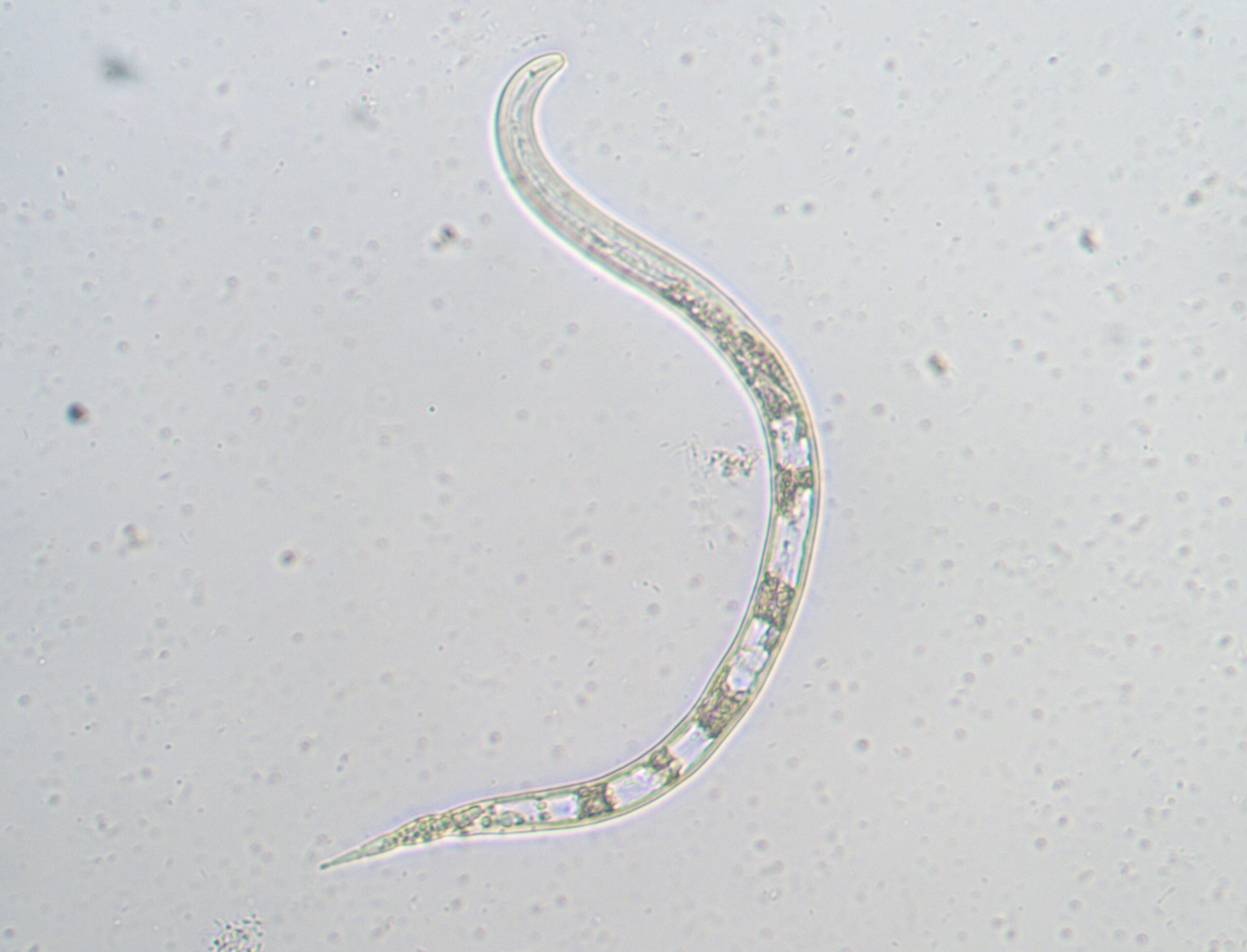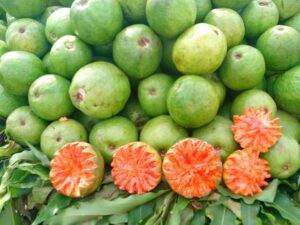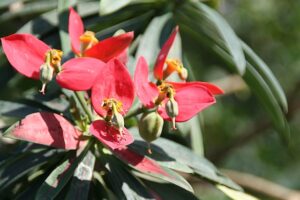Meloidogyne enterolobii
Meloidogyne enterolobii (guava root-knot nematode) is a species of root-knot nematode originally described on the pacara earpod tree (Enterolobium contortisiliquum). The pacara earpod tree genus serves as the derivative for the nematode’s specific epithet! The common name (guava root-knot nematode) derives from the expansion of M. enterolobii into Brazil, where M. enterolobii led to the decline of the guava industry.

Credit: Sam Mowery
Distribution
M. enterolobii was originally described in China on the previously mentioned pacara earpod tree. Following the initial description of M. enterolobii, M. enterolobii’s distribution expanded into other regions of the world. Due to their thermal requirements, M. enterolobii is largely distributed in tropical climates in Africa, Asia, Europe, Central and South America, and the Caribbean (Quesada-Ocampo, 2021). In North America, M. enterolobii has established in the United States in states with warmer climates like North Carolina, South Carolina, Georgia, and Florida.
Symptoms of Infection
As previously mentioned, in sweetpotato, the presence of galls on the fibrous and storage roots is a significant symptom that indicates an infection by a root-knot nematode. Cracking on the storage roots is an additional symptom that may be present. The above-ground symptoms of root-knot nematode infection can include chlorosis, stunting, and plant death. These symptoms are associated with all species of root-knot nematode, not just M. enterolobii. However, M. enterolobii tends to produce more galling on the sweetpotato storage roots than M. incognita (Quesada-Ocampo, 2021).
Identification
As previously stated, the identification of M. enterolobii can only be determined through molecular techniques in a diagnostic laboratory. Sweetpotato symptoms such as root galling and cracking on the storage root serve as great visual diagnostics for root-knot nematode infection, however, species identification is not possible. Although M. enterolobii tends to produce more galling than other root-knot nematodes like M. incognita, the level of galling also depends on host suppressibility, the density of the nematode population, and how aggressive the root-knot nematode species is (Quesada-Ocampo, 2021). Meaning, there are additional factors that contribute to the severity of root galling, not just that of the specific species.
Identification of M. enterolobii within the field or within infected plant tissue begins with collection. Soil samples from an infected field may be collected, packaged, and sent to a diagnostics laboratory for species identification. Like soil samples, infected plant tissue can be carefully removed from the field, packaged, and sent to a diagnostics laboratory. Depending on the diagnostics laboratory, there may be differing sampling or reporting instructions, so it is best to visit their website or call prior to sampling. Given M. enterolobii’s status as an agricultural pest that is under quarantine in North Carolina and Louisiana, it is important to be familiar with quarantine requirements.
Click here to find links to diagnostic laboratories in each state related to the SweetARMOR project.
Host Plants
M. enterolobii has a very broad host range, including vegetables, herbs, field crops, fruits, trees, ornamentals, and even weeds. M. enterolobii is considered an aggressive, highly virulent species of root-knot nematode due to various reports of M. enterolobii overcoming resistance in various crops including tomato, bell pepper, and even sweetpotato! Unlike other species of root-knot nematode, M. incognita, for example, M. enterolobii’s host range has remained large because resistance genes in host crops have often failed to convert hosts to nonhosts for M. enterolobii.
M. enterolobii Reported Host Plants:
The below list has been adapted from the EPPO Global Database, Nemaplex, and the NCSU Extension Sweetpotato Root-Knot Nematode Factsheet.
Vegetables
- Sweetpotato (Ipomoea batatas)*
- Cucumber (Cucumis sativus)
- Bell Pepper (Capsicum annuum)
- Tomato (Solanum lycopersicum)
- Eggplant (Solanum melongena)
- Okra (Abelmoschus esculentus)
- Common Bean (Phaseolus vulgaris)
- Sugar Beet (Beta vulgaris)

“Guava – Psidium guajava fruit of Salem” by Thamizhpparithi Maari / CC BY-SA 4.0
Fruits
- Jackfruit (Artocarpus heterophyllus)
- Common Fig (Ficus carica)
- Guava (Psidium guajava)
- Papaya (Carica papaya)
- Banana (Musa spp.)
- Watermelon (Citrullus lanatus)
Herbs and Spices
- Basil (Ocimum basilicum)
- Ginger (Zingiber officinale)
- Clove (Syzygium aromaticum)

“Malpighiales – Salix babylonica – 12” by Emőke Dénes / CC BY-SA 4.0
Field Crops
- Tobacco (Nicotiana tabacum)
- Upland Cotton (Gossypium hirsutum)
- Soybean (Glycine max)
Trees
- Pacara Earpod Tree (Enterolobium contortisiliquum)
- Weeping Willow (Salix babylonica)
- Crape Myrtle (Lagerstroemia indica)
- Mulberry (Morus spp.)
- Coffee (Coffea arabica)
Ornamentals

“Euphorbia punicea 29zz” by David J. Stang / CC BY-SA 4.0
- Butterfly Bush (Buddleia davidii)
- Gardenia (Gardenia jasminoides)
- Dwarf Poinsettia (Euphorbia heterophylla var. cyathophora)
- Jamacian Poinsettia (Euphorbia punicea)
Wild Plants and Weeds
- Eastern Black Nightshade (Solanum ptychanthum)
- Jerusualem Cherry (Solanum pseudocapsicum)
- Common Blackjack (Bidens pilosa)
(*) Indicates a host species that naturally is susceptible to infection by M. enterolobii but also has genotypes available that are resistant to infection.
Meloidogyne enterolobii and Sweetpotato
As previously mentioned, sweetpotato is within the host range of M. enterolobii. Currently, there are not many commercially available sweetpotato cultivars that are considered resistant to infection by M. enterolobii. Below is a list of sweetpotato cultivars that have been identified as resistant to M. enterolobii.
M. enterolobii Resistant Sweetpotato Cultivars
- Murasaki-29 (Resistant)
- Jewel (Resistant)
- Centennial (Resistant)
Click here to learn more about M. enterolobii resistant sweetpotato cultivars.
Through the SweetARMOR project, the project team aims to develop cultivars that will better fill this gap in resistance in the sweetpotato industry.